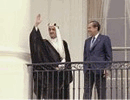The
Saudi Economy:
2004 Performance,
2005 Forecast
Summary |
|
The Saudi Economy
enjoyed the best year of balanced performance in its
history in 2004, with oil sector strength supplemented by
strong growth in most segments of the non-oil private
sector. In many areas -- oil sector capacity expansions,
major petrochemical, power, water and refining projects;
and capital markets activity -- momentum is just beginning,
so we expect the robust economic performance to continue
through 2005.
Oil is still the
anchor of the Saudi economy, and the Kingdom earned $106
billion in oil export revenues in 2004, the highest in its
history, and well above the average of $69 billion for the
previous five years. This resulted in a current account
surplus of $51.5 billion, and a fiscal surplus of SR 98
billion ($26.1 billion).
Underlying the
strength in the oil market was exceptional global growth
in demand for oil in 2004, tightness in the world's oil
production capacity, and a variety of security and supply
disruption concerns in major producing areas.
In this
environment, Saudi Arabia increased production to make up
for supply shortfalls elsewhere and benefited from firm
prices. Prices for Saudi oil averaged $35 per barrel in
2004, while the government based its 2004 budget on a
Samba-estimated $19 per barrel. Benchmark West Texas
Intermediate (WTI) averaged $41.33 per barrel for the
year.
Continued
strength in the global economy in 2005, and thus in oil
demand growth, as well as continued tension in major oil
producing countries, such as Iraq and Russia, portend
another good year for Saudi oil revenues. We believe
prices for Saudi oil will average $30 per barrel for the
year, and production will decline modestly from the 9
million b/d average of 2004, resulting in lower, but still
strong, oil export revenues of $90 billion for Saudi
Arabia in 2005. This will again be well above the
conservative forecast to meet the Kingdom's 2005 budget,
which we estimate was $25 per barrel, and likely result in
fiscal and current account surpluses, more government debt
relief, and further buildup of government reserves.
While the oil
story is impressive, much of the dynamism of the 2004
Saudi economy had nothing to do with oil. The non-oil
private sector grew 5.7 percent, its highest growth since
1982, the last year of the "oil boom" when the
private sector grew 6.3 percent. The best performance came
in telecoms, non-oil manufacturing, and construction.
Fueling some of the non-oil growth were:
- Low
interest rates. Borrowing costs were low for
individuals and businesses.
According to the Ministry of Finance,
through October bank lending in Saudi
Arabia had grown 26.3 percent for the year,
contributing to inflationless
growth in money supply (M3) of 19 percent
for the year through November.
- Major
Projects. Regulatory reform, the strong
global petrochemicals market,
and the transformation of the
long-negotiated "gas initiative"
in the summer of
2003 unlocked many megaprojects in water,
power, and petrochemicals to go
forward. These began to come to market in
2004 and will accelerate in 2005 and beyond.
- Etisalat.
Telecoms liberalization begun long ago
resulted in the entry this year of Etihad
Etisalat of the UAE to build and operate a
second GSM mobile phone network in the
Kingdom. The company's near-term spending in
the Kingdom will top $4 billion.
- Capital
Markets. The successful stock market IPOs of
Sahara Petrochemicals and Etisalat, combined
with the start-up of the new Capital Markets
Authority (CMA) helped drive the sixth year
of the rally in the Saudi stock market in 2004.
The market rose 85 percent in 2004, after a
76 percent gain in 2003.
|
Samba's
"heat map" of the Saudi economy [link
to complete report], a graphic we
produce using 23 economic indicators to gauge the overall
health of the Saudi economy, shows the economy to be the
strongest and most balanced it has been in many years.
These strong
conditions -- high oil revenues, stimulative fiscal policy,
robust non-oil growth, low inflation, and low interest
rates -- are likely to continue into 2005. While oil revenues
will moderate somewhat, the momentum of the private sector
will build. We forecast 2 percent real growth in the oil
sector, 6 percent growth in the private sector, and 3
percent growth in government activity, resulting in
overall real GDP growth in 2005 of 4.25 percent.
Also see:
Saudi
Economic Performance:
A
Conversation with SAMBA Chief Economist Brad Bourland
Arab
World Economies: Prosperity Amidst Political Uncertainty
Brad Bourland
 Brad
Bourland, CFA Brad
Bourland, CFA
Since 1999 Brad
has been the Chief Economist at Samba Financial Group,
formerly Saudi American Bank, in Riyadh, where he
publishes regularly on issues related to the Saudi and
global economies and the world oil market.
He appears frequently in the domestic and
international media and is a regular public speaker.
Brad is also head of country risk management for
the bank, which involves managing the bank's cross-border
risks. Before
joining Samba, Brad spent an 18-year career as diplomat,
economist, and manager with the U.S. Department of State.
During the last three years of his diplomatic
career he was in Riyadh as the American Embassy's First
Secretary responsible for financial affairs, where he
analyzed the Saudi economy for the U.S. Government and
conducted financial aspects of US-Saudi relations.
Brad has his BA and MA magna cum laude from the
University of Utah, and is a CFA (Chartered Financial
Analyst) charterholder.
|



